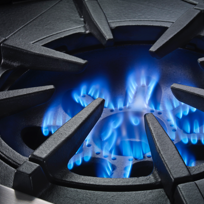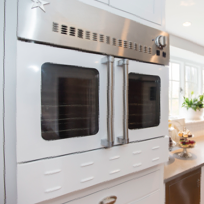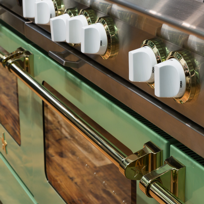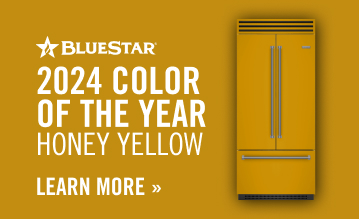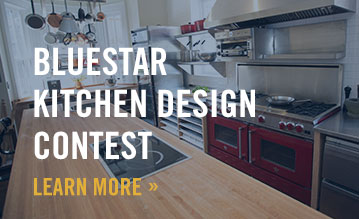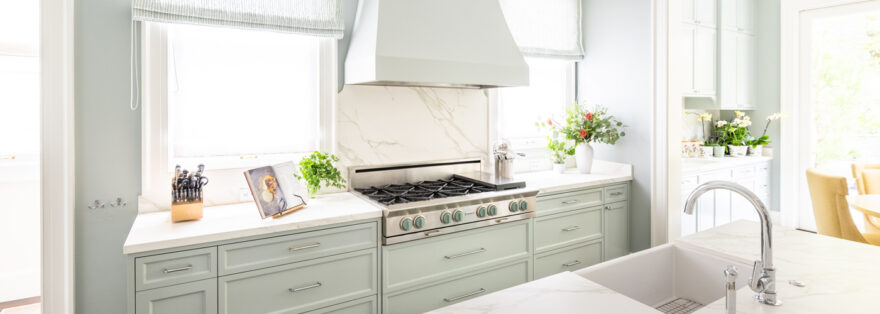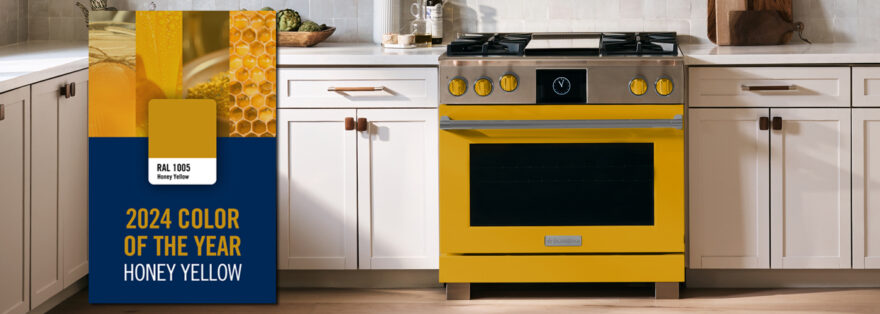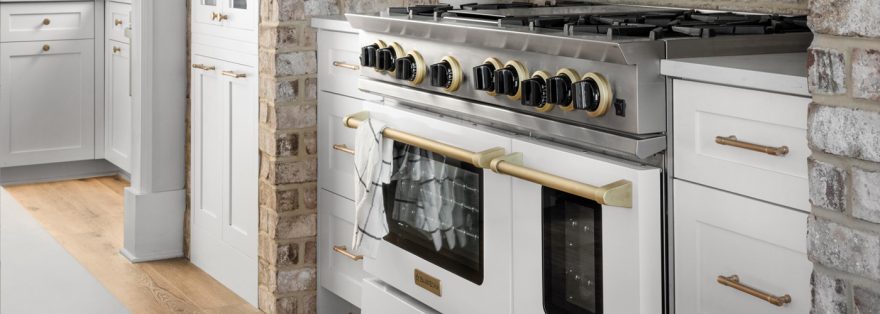AUTHORS Elizabeth Richards
Current trends call for cooking appliances that make preparing a meal easy and fun, while offering options for personal expression in both features and finish.
Cooking capabilities must provide a wide range of options for a wide range of experiences. The needs of homeowners preparing a quick family meal before chauffeuring kids in every direction may require very different appliances than if they are cooking a gourmet meal for guests.
That’s why versatile, easy-to-use appliances are so important. “The top trends in cooking appliances are multi-functional products, automation and customization,” says Rebecca Eubanks, director of product strategy & planning, North America region for Whirlpool in Benton Harbor, MI. “These areas are changing the landscape more rapidly than we have seen historically. As traditional delineations between home, work, travel and play continue to blur, consumer needs are more diverse,” she says. Because consumers expect appliances to do more than one thing, she adds, it is critical that products are flexible and able to adapt to different ways consumers will use them.
At the same time, the way these appliances are integrated into design cannot be ignored. “Appliances are becoming more integral centerpieces of the kitchen that people actually pay attention to,” says Christian Boscherini, marketing and events specialist at SMEG USA in New York, NY. He adds that, when customers are keeping their appliances in full view rather than fully integrated/panel ready, they are showing up in fun, funky colors and patterns.
“New modern luxe consumers curate their kitchens with the thoughtfulness traditionally reserved for other parts of the home,” says Michael Seeley, global design studio leader for Jenn-Air in Benton Harbor, MI. “They are more interested in design and have endless sources of inspiration to turn to when designing their homes. In the kitchen specifically, colors, finishes and materials need to be integrated from a utility standpoint, but also provide flexibility and freedom to make the kitchen a personal expression of self.”
Current trends in cooking appliances aren’t entirely new – they’ve been moving in this direction for several years. “I don’t know that we’re seeing a change in trends as much as an intensification of the trends that were already underway,” says Tony Dowling, v.p., sales & marketing at Elmira Stove Works in Elmira, Ontario, Canada.
These top trends include color, connectivity, specialty and multi-functional and customization. So say manufacturers recently surveyed by Kitchen & Bath Design News.
Connected Cooking
In our technology-driven world, connectivity is important everywhere – and cooking appliances are no exception. Most manufacturers say they see a rise in demand for “smart” appliances that provide both convenience and cooking assistance.
Boscherini says that people are looking for appliances that essentially do the cooking for the owner. That means technology-driven, WiFi-enabled appliances with touchscreens instead of knobs, he says. “Trends have changed significantly due to the growth of technology. Customers are looking for appliances they can operate from their phones without having to be home,” he adds.
“People are interested in WiFi connectivity – to program [and] view settings remotely, service monitoring and a host of other functions. Additionally, menu-driven operation – whereby the appliances walk a user through a recipe – is also appealing to those who need an assist when making meals,” says Paula Smith, AKBD, marketing director – Builder/Designer at Fisher & Paykel in Costa Mesa, CA.
Dowling says smart, connected appliances are trending as consumers seek simplicity, as well as excellent performance and results. “We’re more and more focused on how our meals look, smell and taste. The sizzle sells the steak,” he says.
Touch controls are another trend in kitchens, notes Peter Weedfald, senior v.p. of sales and marketing at Sharp Home Appliances, headquartered in Montvale, NJ. “Knobs, switches and buttons are fading in exchange for controls that are sleek, responsive and easier to clean,” he says.
On the flip side, Melissa Haber, v.p. of EuroChef and Verona Appliances in Edgewood, NJ is seeing a return to traditional style appliances. “While advancements in technology have led to the incorporation of ‘smart’ devices into the kitchen, this also comes with the disadvantage of expensive upgrades, mechanical breakdowns and a whole host of issues that comes with expensive software,” she points out.
Diverse Functionality
Options are important, and manufacturers say that both specialty and multi-functional cooking appliances are in demand.
“We noticed that homeowners want versatility in their kitchen, which is exactly why we’ve placed sous vide, induction and gas in one appliance,” says Zach Elkin, general manager, Signature Kitchen Suite, in Englewood Cliffs, NJ. “Homeowners are looking for advanced culinary features that help them achieve professional level, gourmet results at home. We call them ‘Technicureans,’ a new generation of forward-thinking chefs,” he adds.
Haber says, “In larger kitchens, it is appealing to have one or more specialty products – steam, convection steam, speed, coffee maker – so that consumers have a variety of options with which to prepare food. In smaller kitchens, especially, multi-function ovens are almost a necessity,” she continues. “Speed or convection steam ovens can provide a number of modes for cooking in one cavity. While they are often considered companion products to a convection oven, in some cases they can serve as the primary oven, given the functionality they offer.”
Seeley notes, “There’s so much diversity in the culinary world today that people are seeking out multiple specialty devices. There’s a constant curation of kitchen staples paired with the specialty appliances [consumers] need.”
Air fryers and Instant Pots are two of the most popular specialty functions, manufacturers agree. “People love the idea of an all-in-one product, as well as faster results,” Eubanks says. “Air fry provides good results with a health benefit that is very compelling for consumers. We are currently seeing some of these secondary cooking techniques being integrated into other techniques, like cavity cooking. Consumers definitely want an all-in-one product – especially if the performance is equal and it frees up counter space.”
Healthy, Busy Lifestyles
People are often “on the run,” with limited time for cooking. At the same time, they want healthy options for meal preparation. That drives demand for cooking appliances that allow for quick, convenient, healthy cooking.
“We see families focusing on new healthy cooking habits, and living more sustainably,” states Eloise Hale, spokesperson for Electrolux North America, based in Charlotte, NC. “They want appliances to support this,” she says. “This trend will continue in the next five year as families prioritize their lifestyle and sustainability goals.”
Weedfald sees steam ovens trending upward. “A favorite method of cooking overseas, steam ovens in the U.S. had largely been the domain of restaurant kitchens in the form of free-standing combi-ovens as tall as your refrigerator and costing tens of thousands of dollars. Superheated steam ovens are remarkable.”
“Induction is going more mainstream,” Smith points out. “Between the consumer population becoming more educated about induction cooking and issues like the Berkeley, CA ordinance that bans gas on new MF construction, it is gaining ground.”
Sous vide is also catching on, Smith says. Convection steam and speed ovens are also popular in the premium segment, she adds. “The quality, flexibility and time savings that both types of units offer are very appealing to consumers these days. Who isn’t always so crazy busy?”
Elkin cites research from The Research Institute for Cooking & Kitchen Intelligence (RICKI) that revealed increased demand for dual-fuel appliances in the past year, as well as a rise in convection and induction cooking. “These types of innovations are bringing even more approachable, yet advanced, cooking methods to the home kitchen,” he notes.
Brave New Color
Stainless steel has been the standard in cooking appliances for a very long time, but manufacturers say there is more interest in color now than ever before. This may be a pop of color on a countertop appliance, color enamel on a full-size range or a move away from stainless to a neutral color like black or white.
“Color options are appealing to people as they offer them an opportunity to have something a little different than stainless steel. In some cases, they desire the ‘pop’ of a red range, while in others they like the colors to blend in more seamlessly with their cabinetry,” says Smith.
“Color has the power to transform a room, and painted appliances can completely transform a kitchen,” notes Eliza Sheffield, president at BlueStar in Blandon, PA. “While stainless remains a popular premium finish, we’ve seen a rise in what we call ‘stainless fatigue.’ It’s been around for so long, people are feeling that their kitchens are looking cookie-cutter, as opposed to the upscale, differentiated look that stainless always implied. Clients are telling design professionals that they do not want a kitchen that looks like everyone else’s,” she says.
Neutral colors in kitchens, from grays to varying shades of white, make a great backdrop for pops of color, she adds. “We see people going for sharp contrast. With neutral cabinets, a glossy red or cobalt blue range can stand out among subdued cabinets, or even a bold color like green can look elegant against a white cabinet.”
“We seem to be at, or certainly near, the tipping point on color,” Dowling adds. As more manufacturers show color, more retailers will display it, and customers will begin to see color as something they should consider, Dowling believes. “The drops of color in the sea of stainless are turning into a wave.”
Eubanks agrees that more color options are offered now, including fingerprint-resistant stainless, black stainless, matte black and bronze steel. “Color is important and, in the future, I see the need to customize and personalize to meet consumer needs,” she states.
Both matte and glossy blacks have quickly become the top finish choices for kitchen appliances, Haber notes, and the trend shows no signs of slowing down. “Typically paired against light cabinetry, black is a color that never goes out of style and pairs well with any color palette and interior style,” she says.
Boscherini asserts, “Color is important, but customers still shy away from it because they aren’t accustomed to having colorful appliances. Consumers are accustomed to white, black or stainless appliances.” While full-color ranges or hoods may seem intimidating to clients, he adds, they are looking for tasteful ways to bring pops of color into their kitchen.
Sheffield sees a move toward matte, rather than high-gloss, finishes. Matte finishes soften colors for a more natural, low-tech look, she says. “A smooth, velvety matte surface provides a rich, warm tone that is soft on the eyes and forgiving on fingerprints. Whereas a glossy sheen sometimes can make a strong color appear a bit too harsh, a matte finish can actually soften bolder looks. You can even go dark with blacks, deep purples, ruby reds or cobalt blues for a feel that’s opulent yet relaxed.”
Still Stainless
This move to color doesn’t mean that stainless steel has given up its throne. “Stainless steel is king. That isn’t changing any time soon,” Weedfald believes. “Although color has had great success in countertop appliances, it is very restrictive in large kitchen appliances.” Gray, though maybe not exciting, had a moment since the entire look wouldn’t fall apart when it came time to upgrade or replace appliances, he says. “The same would probably be true with the new white appliances with stainless steel handles and trims…you could still retreat to the safety of stainless steel.”
Black stainless, he says, has seen a steady rise in popularity due to its elegant contrast, bold statement and growing catalog. “As your family’s needs change, your appliances will too,” he says. “Sticking with the classics means stress-free upgrades and replacements.”
Hale agrees that stainless steel is still the overwhelming finish preference. “Consumers also love smudge-proof coatings over their stainless finish to hide fingerprints,” she adds.
“Luxury kitchen designers’ love affair with stainless steel shows no signs of slowing down,” notes Elkin. “In fact, RICKI reported that 45 percent of designers see stainless trending up and 38 percent see paneled appliances trending up, too. These are classic, sophisticated designs that remain popular and continue to dominate kitchen projects.”
Express Yourself
With all the options available, it’s easier for designers to meet the demand for personalized, custom appliances. Whether in finish or function, manufacturers say the ability to “make it their own” is important.
“[People] want creative freedom to build kitchens that align with their unique tastes and reflect their personalities. For appliance designers, this is an exciting trend to lean into. Instead of auto-pilot decision making, people are prioritizing choice over convention, progress over stagnation,” says Seeley.
“People today are more plugged into culinary endeavors and experiences than ever before. They are turning to cooking for the experience it offers and its ability to serve as a form of self-expression. They use cooking to reflect their heritage or reflect on recent travels; the influence is broad, and they are bringing all of it home,” he adds.
Sheffield notes that BlueStar is rolling out a new customization capability with an exclusive, cutting-edge printing process that allows any image, text, print or pattern to be applied to a range, refrigerator or kitchen hood, in a durable and smooth, satin-like finish.
“Customization in kitchen design is a major trend we are seeing for 2020,” says Haber. “In the past, appliances were primarily available in the standard stainless steel finish, which limited the creativity and personalization of a kitchen’s design.”




